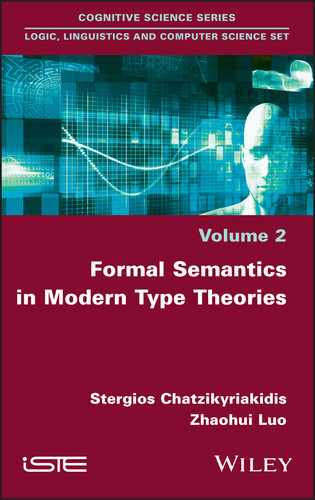Appendix 4
And for Coordination
In Chatzikyriakidis and Luo (2012), we have only studied how to give generic typing to coordinating connectives such as “and”, but not how to characterize their semantic behaviors. For example, as described in section 2.3.2, we have introduced the universe LTYPE with which “and” can be interpreted as And : ΠA:LTYPE. A → A → A, but we have not described ways to define the semantic operator And.
This appendix is based on the second author’s notes (Luo 2018b). It uses And as an example to describe how to define behaviors of coordinating connectives for each type in LTYPE. Formally, the introduction rules of LTYPE are given in Figure A4.1 – it contains the following three kinds of types as its objects:
- 1) the predicate types of the form Πx1:A1...Πxn:An.P rop;
- 2) the types representing CNs (i.e. the types in CN);
- 3) the universe CN itself.

Figure A4.1. Introduction rules for LTYPE
For each A : LTYPE, the semantic behavior of And(A) : A → A → A is characterized by case analysis on A as follows:
1) If A = Πx1:A1...Πxn:An.Prop then, for any f, g : A,
And(A, f, g)(x1, ..., xn)=df f(x1, ..., xn) ∧ g(x1, ..., xn) : Prop.
When n = 0, the above reduces to (2.36) in section 2.3.2.
2) If A : CN then, for any distributive predicate P : A → Prop,1
3) If A = CN, then for A1,A2 : CN and for C : CN such that Ai ≤ C (i = 1, 2),
And(CN, A1, A2)=df Σx:C. ISC (A1,x) ∧ ISC (A2,x),
where IS is the operator for propositional forms studied in section 3.2.3 and section 7.1.
Then, the examples (2.25-2.32) in section 2.3.2 are given semantics as follows:
(A4.1) (sentences)
- [[John walks and Mary talks]]
- = And(Prop, walk(j), talk(m)) = walk(j) ∧ talk(m).
(A4.2) (verbs)
- [[John walks and talks]]
- = And(Human → Prop, walk, talk)(j) = walk(j) ∧ talk(j).
(A4.3) (adjectives)
- [[Mary is pretty and smart]]
- = And(Human → Prop, pretty, smart)(m) = pretty(m) ∧ smart(m).
(A4.4) (adverbs)
- [[The plant died slowly and agonizingly]]
- = And(T, slowly, agonizingly)(Plant, die, the_plant)
- = slowly(Plant, die, the_plant) ∧ agonizingly(Plant, die, the_plant), where T = ΠA:CN.(A → Prop) → (A → Prop).
(A4.5) (quantified NPs)
- [[Every student and some professors came]]
- = And((Human → Prop) → Prop, ∀(Student), ∃(P rofessor))(come) = ∀(Student, come) ∧∃(P rofessor, come).
(A4.6) (quantifiers)
- [[Some but not all students got an A]]
- = And(T, some, notAll)(Student, getA)
- = ∃(Student, getA) ∧¬∀(Student, getA), where some and notAll are of type T = ΠA:CN.(A → Prop) → Prop and defined as some(A, P) = ∃(A, P) and not All(A, P) = ¬∀(A, P).
(A4.7) (proper names)
- [[John and Mary went to Italy]]
- = goItaly(And(Human, j, m)) = goItaly(j) ∧ goItaly(m).
(A4.8) (CNs)
- [[A friend and colleague came]]
- = ∃(And(CN, Friend, Colleague), come)
- = ∃(Σx:Human.IS(Friend, x) ∧ IS(Colleague, x), come)
- ⇔ ∃x:Human. IS(Friend, x) ∧ IS(Colleague, c) ∧ come(x).
- 1 Note that there is no such reductive equation for a verb whose semantics is a collective predicate, as illustrated by a sentence such as “Whitehead and Russell wrote Principia Mathematica”.
